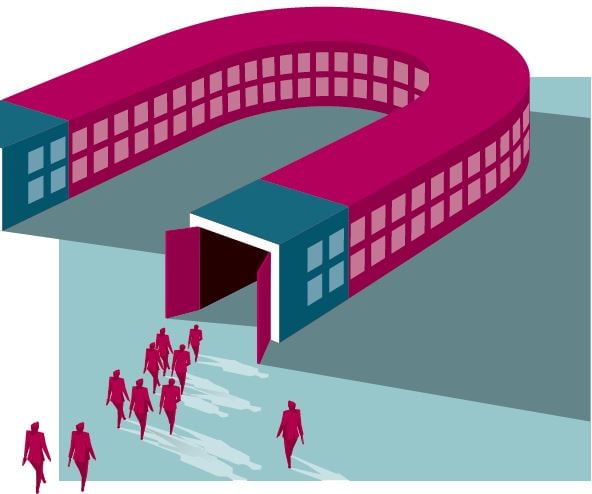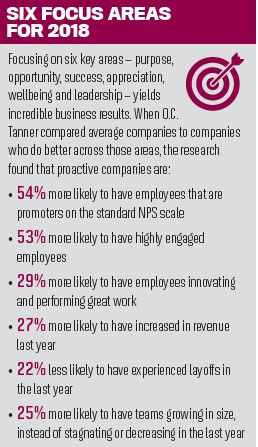
It can be difficult to know where to focus engagement efforts, but new research shows the essential areas for HR to concentrate on in 2018

It can be difficult to know where to focus engagement efforts, but new research shows the essential areas for HR to concentrate on in 2018
The O.C. TANNER Institute’s 2017 global study, The Six Essential Aspects of Workplace Culture to Focus on Today, revealed the fundamental building blocks for any successful culture. The study found that the six key aspects most meaningful to employees are purpose, opportunity, success, appreciation, wellbeing and leadership. These talent magnets positively impact recruitment, engagement, tenure, and satisfaction – not to mention business metrics. They are critical for creating an employee’s connection to the company – that is, the employee’s connection with their role, their colleagues, their manager, the workplace as a whole – and just as importantly, their connection to the purpose of the workplace and its connection to the wider community.
Creating a connection
On the last item, Alan Heyward, managing director Australasia at O.C. Tanner | Accumulate, says there’s an increasing trend of employees asking: ‘Why am I doing this?’ “People want to know they’re making a difference,” he says.
While he’s reluctant to place this trend at the feet of millennials, Heyward does concede this cohort has demanded changes in the way they work, where they work – and why they work.
Employee connection is similar to the employee experience – that is, ensuring each touchpoint an employee has with their employer is a positive experience – however, Heyward suggests employee connection extends beyond this. For example, it ties closely with the demand for greater personalisation of HR services.
“Employees increasingly want to feel they are not just a number that is getting a generic experience; instead, they want a tailored experience in terms of the types of development opportunities that are being presented to them, the way their leaders are dealing with them, and how they like to be recognised,” Heyward explains. “It’s part of them feeling valued as employees – getting that sense of, ‘You know me, so you’re tailoring the experience as much as you can.’ ”
However, a word of warning: Heyward says the term personalisation is so broad that it’s a bit like the word social. “It means different things to different people,” he says. “Personalisation can mean deep personalisation, in other words talking to you and communicating with you as an individual. But it can also mean talking to and communicating with a team, which might be different to how you talk to and communicate with another team. So there are different levels of personalisation that are relevant for different purposes.”
He cites the example of L&D. It’s unlikely any organisation has the resources to tailor messaging to every single worker in a 30,000 employee organisation. However, at the same time, it’s far from effective to provide a suite of 100 courses to everyone, of which perhaps only two or three are relevant. “You’d approach a team or division and say, ‘Here are the courses that are relevant to you – you might want to consider this.’ ”

Recognition and appreciation are fundamental elements of engagement, and there are changes afoot in this space, too. Over the past 12 months, there has been a trend towards the more sophisticated use of data to shape and hone recognition programs, and to use the data gathered by recognition systems to inform broader business decisions.
“This data is being used to help enhance the performance of programs and to help with broader strategic decision-making, but also to identify the hidden hierarchies in organisations,” Heyward says. “It’s helping to identify key influencers or change champions – those people who are so critical to the design, rollout and sustained use of recognition programs.”
There has also been a growing understanding that implementing a recognition program requires more than a team of people in HR pulling together a strategy around recognition, obtaining the CEO’s buy-in and launching it. There needs to be engagement of stakeholders up and down the hierarchy as part of the process.
“If HR wants to put in place a recognition program and for it to work well, that engagement needs to happen early – in terms of how you design the program and establishing what it’s there for,” Heyward says. “You need to find those champions who will support it, but you also need to get the executives involved. The greater the buy-in and usage from executives, the greater the buy-in and usage from everyone.”
Another emerging trend is leaders thinking about the employee experience in broader terms and not restricting it to when a person starts with a company and when they leave the company. “Clients are showing an interest in creating connections pre-start date and also after someone has left an organisation, via alumni recognition programs. An employee may leave the organisation but still want to stay connected to it. The connection doesn’t have to end the day they leave. Recognition can play a key role. Who says you only need to recognise people in the workplace? You may want them to rejoin down the track. Stay connected to them.”
Heyward is also witnessing a greater need for larger organisations operating across different regions to have truly global recognition solutions. O.C. Tanner has that global reach and expertise.
“Clients are saying they want to work with one party that can deliver programs across perhaps 30 countries – and they want to be able to do that while also factoring in local nuances. Everyone likes to be thanked, everyone likes to be appreciated, but how that is delivered varies across different regions,” he says. “Having a common framework or platform means you’re also pulling together the consolidated data you have flowing through your organisation, rather than having separate programs in separate regions run by separate suppliers.”
The human touch
One lasting legacy of 2017 will be the increased awareness of job automation – people losing their jobs to machines or AI-driven computers. Does Heyward believe this will ever impact the recognition space?
“Technology has a role to play, especially in terms of communication, but recognition and appreciation will always be grounded in personal emotional connections,” he says. “I personally hope we never get to a place where recognition and appreciation becomes fully automated, because that would devalue the role that recognition and appreciation actually plays in helping people feel connected and socially aligned and all those positive things.”
For further information and insights on improving workplace culture and engagement, contact us on 1300 733 725 or visit www.octanner.com/au